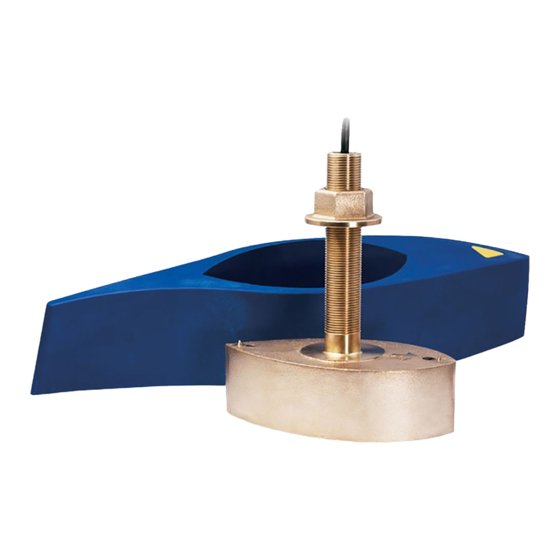Table of Contents
Advertisement
Quick Links
OWNER' S GUIDE
Thru - Hull, Metal Stem
Depth Transducer
Models: B45, B46, B258, B260,
SS258, SS260, SS261, SS270W, SS505, SS560
IMPORTANT : Please read the instructions completely
before proceeding with the installation. These
instructions supersede any other instructions in your
instrument manual if they differ.
CAUTION : NEVER USE SOLVENTS!
Cleaners, fuel, paint, sealants, and other products may
contain strong solvents, such as acetone, which attack
many plastics greatly reducing their strength.
Applications
• Bronze transducer recommended for fiberglass or wood hulls.
Never mount a bronze transducer in a metal hull, because
electrolytic corrosion will occur.
• Stainless steel transducer compatible with all hull materials.
Recommended for aluminum hulls to prevent electrolytic corrosion
provided the stainless steel transducer is isolated from the metal hull.
Caution : Installation requires using a fairing kit to isolate the
stainless steel transducer from a metal hull.
• Never install a metal transducer on a vessel with a positive
ground system .
Tools & Materials
Safety goggles
Dust mask
Electric drill
Drill bits:
Pilot hole
B45, B46, SS505
B260, SS260, SS261,
SS270W, SS560
B258, SS258
Sandpaper
Mild household detergent or weak solvent (such as alcohol)
File (installation in a metal hull)
Fairing (MANDATORY FOR SS261 AND SS560)
Angle finder or digital level (installation with a fairing)
Band saw or hand saw (installation with a fairing)
Rasp or power tool (installation with a fairing)
Marine sealant (suitable for below waterline)
Slip-joint pliers
Zip-ties
Water-based antifouling paint ( MANDATORY IN SALT WATER )
Installation in a cored fiberglass hull: (see page 4)
Drill bit for hull interior:
B45, B46, SS505
B260, SS260, SS261,
SS270W, SS560
B258, SS258
Cylinder, wax, tape, and casting epoxy
&
3mm or 1/8"
22mm or 7/8"
33mm or 1-5/16"
30mm or 1-3/16"
35mm or 1-3/8"
42mm or 1-5/8"
40mm, 41mm, or 1-5/8"
INSTALLATION INSTRUCTIONS
Record the information found on the cable tag for future reference.
PN:___________________Date___________Frequency________kHz
B45
High-Performance
Identify Your Model
The model name is printed on the cable tag.
About Fairings
Nearly all vessels have some deadrise angle at the mounting
location. If the transducer is mounted directly to the hull, the
sound beam will be tilted to the side at the same angle as the
deadrise. A fairing is strongly recommended if the deadrise angle
exceeds 10 ° .
• Orients the sound beam straight down by mounting the
transducer parallel to the water surface.
• Mounts the transducer deeper in the water for clean flow over
the transducer's face.
Made of a high-impact polymer with an integrated cutting guide,
an Airmar fairing is safer and easier to cut with a band saw and
shape with hand tools than custom fairings. It can be shaped to
accommodate a deadrise angle of up to about 25 ° . (For fairing
part numbers, see "Replacement Parts" on page 4.)
A backing block is mounted inside the hull to provide a level
surface for the hull nut to seat against (see Figure 2). It is
fabricated matching the interior deadrise angle of the boat. After
cutting an Airmar fairing, use the remaining section with the
cutting guide for the backing block.
High-Performance Fairing has a long streamlined shape for
excellent performance above 15kn (18MPH). (To order see
"Replacement Parts" on page 4.)
Mounting Location
• The water flowing across the hull must be smooth with a
minimum of bubbles and turbulence (especially at high speeds).
Caution : DO NOT MOUNT near water intake or discharge
openings or behind strakes, fittings, or hull irregularities.
• The transducer must be continuously immersed in water.
• The transducer beam must be unobstructed by the keel or
propeller shaft(s).
• Choose a location away from interference caused by power and
radiation sources such as: the propeller(s) and shaft(s), other
Standard
Fairing
Fairing
Advertisement
Table of Contents

Summary of Contents for Airmar B45
- Page 1 Made of a high-impact polymer with an integrated cutting guide, Dust mask an Airmar fairing is safer and easier to cut with a band saw and Electric drill shape with hand tools than custom fairings. It can be shaped to Drill bits: accommodate a deadrise angle of up to about 25 °...
- Page 2 fin keel 300–600mm (1–2'). Figure 2. Bedding and installing in a metal hull • Full keel sailboat —Locate amidships and away from the keel (B45 with Standard Fairing shown) at the point of minimum deadrise angle. Copyright © 2005, 2007 Airmar Technology Corp.
- Page 3 If the cable must be cut and 6. Shape the fairing to the hull as precisely as possible with a rasp spliced, use Airmar’s splash-proof Junction Box No. 33-035 and or power tool. follow the instructions provided. Removing the water-proof 7.
- Page 4 Figure 6. Preparing a cored fiberglass hull email: sales@airmareurope.com Copyright © 2005 Airmar Technology Corp. AIRMAR ® 35 Meadowbrook Drive, Milford, New Hampshire 03055-4613, USA TECHNOLOGY CORPORATION www.airmar.com ■ Copyright © 2003, 2005, 2007 Airmar Technology Corp. All rights reserved.

















Need help?
Do you have a question about the B45 and is the answer not in the manual?
Questions and answers